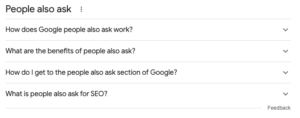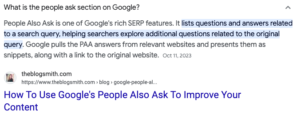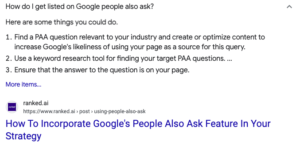What Is PAA In SEO?
Google continually innovates to sustain its dominance in the market. As the leading search engine globally, it has enhanced its capability to predict user search queries and deliver relevant and actionable answers. Google employs visually appealing elements like boxes containing text and other materials to guide users effectively. A key example of this is the People Also Ask Box, or PAA box.
Table of Contents
- What is the People Also Ask feature in Google?
- Understanding Google’s People Also Ask Feature
- Origin of Content in People Also Ask Boxes
- In-Depth Insights on PAA Boxes
- The Value of PAA Boxes
- Is People Also Ask Google Optimization Worth It?
- How Do You Get Featured in People Also Ask?
- Maximizing Visibility with PAA Boxes
- Leveraging PAA for Content Ideation and Planning
What is the People Also Ask feature in Google?
The People Also Ask box is a feature in Google searches that offers questions and answers related to the user’s search terms. It reflects Google’s estimation of what the user might want to know. Unlike the brief descriptions under typical search results, the People Also Ask box takes up more space and is more visually prominent. It represents Google’s way of suggesting the most appropriate response to a user’s search inquiry.

Understanding Google’s People Also Ask Feature
The People Also Ask (PAA) feature is a dynamic aspect of Google’s search experience. It presents related questions and answers based on the user’s initial search term. This feature reflects Google’s interpretation of what the user might want to know, offering a more prominent and engaging visual space compared to traditional search results. Essentially, Google is suggesting, “This could be the most fitting response to your question.”
- Utilize PAA boxes to enhance organic search presence and brand visibility.
- Optimize content format and clarity for better chances of PAA feature.
- Analyze and leverage PAA for fresh content ideas and filling content gaps.
- Implement FAQ schema to make content more comprehensible to search engines.
- Explore PAA trends for aligning content with user intent and SEO strategy.
PAA boxes are crucial for enhancing organic search performance as they increase brand visibility. Interestingly, not all content in PAA boxes needs to rank on the first search engine results page (SERP) to be featured. This is significant for targeting high-competition keywords that might be challenging to rank for otherwise. A study by SEMrush revealed that about 75% of pages providing answers in PAA boxes did not appear in the top ten search results, presenting an exceptional chance for well-optimized pages to gain prominence quickly.
Where does the text in a People Also Ask box come from
Content for PAA boxes is sourced directly from websites. Google utilizes its extensive understanding of search trends to identify and link to web pages that most effectively answer specific queries. The responses in a PAA box can vary, including paragraphs, lists, tables, or videos. As Google continues to refine the PAA feature, we can expect to see a broader range of content formats being tested.

In-Depth Insights on PAA Boxes
PAA Boxes Versus Featured Snippets
PAA boxes, appearing in an accordion layout within SERPs, differ from featured snippets, which are typically placed at the top. Each search phrase generally has one or two featured snippets, derived from a page already ranking high for the relevant keyword.
A notable difference between PAA boxes and featured snippets is that a single PAA question can be linked to various queries. Thus, if your content answers a PAA question, it could be displayed in SERPs for related searches you haven’t yet ranked for. This scenario is not the case with featured snippets, which are specific to each individual keyword.
While PAA boxes are not present for every query, they are more common than featured snippets, appearing in about 65% of SERPs compared to the latter’s 6%. Featured snippets are typically restricted to informational queries, whereas PAA boxes cover a wider array of questions and topics.
Both PAA boxes and featured snippets can appear in diverse formats. Discover strategies for optimizing for a featured snippet [here].
The Value of PAA Boxes
PAA boxes significantly broaden your initial engagement reach. As they often cater to users in the initial stages of their research or awareness journey, delivering precise, succinct answers in these prominent spaces can attract potential clients.
The placement of People Also Ask boxes varies across a SERP. Some display a finite number of questions, while others seem endless, revealing more queries as users explore them. This feature might direct users to your content, even if it’s not directly linked to your targeted keywords.
Being featured in a PAA box lends a degree of credibility to your site, potentially leading to more organic links and references, vital for enhancing SEO.
To improve your chances of appearing in PAA boxes:
- Ensure your page directly answers the targeted question, using clear and structured language.
- Create trustworthy and actionable content aligned with your target keyword’s search intent.
- Implement FAQ schema to clarify the quality and context of your content to search engines.
Is People Also Ask Google Optimization Worth It?
The effectiveness of optimizing for PAA boxes in your SEO strategy can vary. While being featured in a PAA box doesn’t guarantee increased traffic or ranking jumps, it’s notable that interaction rates with these boxes can be significant, reaching up to 13% in some cases.
PAA boxes connect you to users seeking specific answers and serve as a tool for content research. Integrating PAA optimization into your content strategy can unveil new topic ideas, ensure comprehensive coverage of a subject, and potentially expand your visibility in search results.
How Do You Get Featured in People Also Ask?
To enhance your chances of being featured in PAA boxes:
- Research Your Keywords: Start by Googling your chosen keywords and explore relevant PAA boxes. Note the format of current answers (paragraph, list, etc.) and aim to improve upon them in your content.
- Optimize Existing Content: Check if your primary and secondary keywords trigger PAA boxes. Incorporate these questions and your answers into your blog posts or landing pages, or consider adding an FAQ section.
- Add FAQ Schema: Format your FAQ sections with clear, concise answers under headings (like h3). For binary questions, start with a direct ‘yes’ or ‘no’. Implement FAQ schema to highlight the Q&A nature of your content to Google.

Maximizing Visibility with PAA Boxes
To enhance your content’s visibility in People Also Ask (PAA) boxes, consider these strategies:
- Engaging Content: Craft your answers with engaging and clear language. This will not only catch the reader’s attention but also increase the likelihood of Google selecting your content for PAA boxes.
- Mobile Optimization: Since a significant portion of searches occur on mobile devices, ensure your content is mobile-friendly. This increases the chances of your content being featured in PAA boxes for mobile users.
- Multimedia Integration: Incorporate relevant images, videos, and infographics in your content. This can make your PAA box entry more appealing and informative, leading to higher engagement rates.
Leveraging PAA for Content Ideation and Planning
People Also Ask boxes can be a goldmine for content ideation and planning:
- Identifying Gaps in Content: By analyzing the questions in PAA boxes, you can identify topics that your current content might not cover. This helps in filling those gaps and addressing the audience’s needs more effectively.
- Content Calendar Development: Use the insights gained from PAA boxes to plan your content calendar. This ensures that your content is timely, relevant, and aligned with current search trends and user interests.
- New Topic Generation: The variety of questions in PAA boxes can inspire new content topics, helping you to diversify your content and explore new angles and perspectives in your niche.

